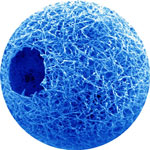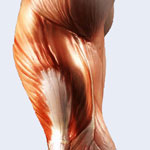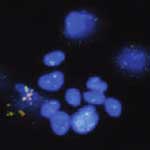Showing Spotlights 337 - 344 of 556 in category All (newest first):
 The potential use of antimicrobial surface coatings ranges from medicine, where medical device infection is associated with significant healthcare costs, to the construction industry and the food packaging industry. Thin films containing silver nanoparticles have been seen as promising candidate coatings. Silver is known as one of the oldest antimicrobial agents. Silver ions are thought to inhibit bacterial enzymes and bind to DNA. Silver nanomaterials have been used effectively against different bacteria, fungi and viruses. Using something like an advanced form of a rubber stamp, scientists have now developed a way to adhere an ultra-thin (just a few molecules thick) antibacterial coating to a wound. The "stamped" area shows bactericidal activity for at least 48 hours.
The potential use of antimicrobial surface coatings ranges from medicine, where medical device infection is associated with significant healthcare costs, to the construction industry and the food packaging industry. Thin films containing silver nanoparticles have been seen as promising candidate coatings. Silver is known as one of the oldest antimicrobial agents. Silver ions are thought to inhibit bacterial enzymes and bind to DNA. Silver nanomaterials have been used effectively against different bacteria, fungi and viruses. Using something like an advanced form of a rubber stamp, scientists have now developed a way to adhere an ultra-thin (just a few molecules thick) antibacterial coating to a wound. The "stamped" area shows bactericidal activity for at least 48 hours.
May 5th, 2011
 Damaged articular cartilages, like the ones found in the knee joint, ordinarily demonstrate a very limited capability for self-healing. Functional restoration of diseased or damaged articular cartilage is a major clinical challenge. There have been a number of successful approaches to tissue engineered cartilage, including the use of natural and synthetic biomaterial scaffolds. Although recent progress has been made in engineering cartilage of various shapes and sizes for cosmetic purposes, current treatments for cartilage repair are less than satisfactory, and rarely restore full function or return the tissue to its native state. Researchers have now developed nanofibrous hollow microspheres self-assembled from star-shaped biodegradable polymers as an injectable cell carrier. When the spheres are injected with cells into wounds, these spheres biodegrade, but the cells live on to form new tissue.
Damaged articular cartilages, like the ones found in the knee joint, ordinarily demonstrate a very limited capability for self-healing. Functional restoration of diseased or damaged articular cartilage is a major clinical challenge. There have been a number of successful approaches to tissue engineered cartilage, including the use of natural and synthetic biomaterial scaffolds. Although recent progress has been made in engineering cartilage of various shapes and sizes for cosmetic purposes, current treatments for cartilage repair are less than satisfactory, and rarely restore full function or return the tissue to its native state. Researchers have now developed nanofibrous hollow microspheres self-assembled from star-shaped biodegradable polymers as an injectable cell carrier. When the spheres are injected with cells into wounds, these spheres biodegrade, but the cells live on to form new tissue.
May 4th, 2011
 Heparin is widely used as an anti-coagulant to prevent the formation of blood clots. This naturally occurring biological molecule is commonly used during surgery for blood thinning. At the end of surgery, heparin has to be removed in order to allow the blood to clot again - this is currently done using a protein called protamine, the only clinically approved heparin binder. Unfortunately, protamine can cause severe allergic reactions in a number of patients. Researchers at the University of York have now developed a synthetic molecule which is capable of binding heparin just as effectively as protamine. The team's approach may eventually be useful for developing protamine replacements.
Heparin is widely used as an anti-coagulant to prevent the formation of blood clots. This naturally occurring biological molecule is commonly used during surgery for blood thinning. At the end of surgery, heparin has to be removed in order to allow the blood to clot again - this is currently done using a protein called protamine, the only clinically approved heparin binder. Unfortunately, protamine can cause severe allergic reactions in a number of patients. Researchers at the University of York have now developed a synthetic molecule which is capable of binding heparin just as effectively as protamine. The team's approach may eventually be useful for developing protamine replacements.
May 2nd, 2011
 A few years ago, researchers determined that the stiffness of cancer cells affects the way they spread. When cancer is becoming metastatic, or invading other organs, the diseased cells must travel throughout the body. Because the cells need to enter the bloodstream and maneuver through tight anatomical spaces, cancer cells are much more flexible, or softer, than normal cells. With this knowledge, researchers wanted to understand the cell mechanics associated with the anticancer treatment of cells from patient samples; in particular they were interested in reporting the effects of green tea extract due to the fact that is was a natural product, it has know anti-cancer effects and it is widely consumed in beverage form around the world.
A few years ago, researchers determined that the stiffness of cancer cells affects the way they spread. When cancer is becoming metastatic, or invading other organs, the diseased cells must travel throughout the body. Because the cells need to enter the bloodstream and maneuver through tight anatomical spaces, cancer cells are much more flexible, or softer, than normal cells. With this knowledge, researchers wanted to understand the cell mechanics associated with the anticancer treatment of cells from patient samples; in particular they were interested in reporting the effects of green tea extract due to the fact that is was a natural product, it has know anti-cancer effects and it is widely consumed in beverage form around the world.
Apr 5th, 2011
 Brain-computer interfaces, neural probes, brain implants - they all require intensive in vivo studies on how to best combine inorganic electronics with organic neurons. Currently, most neural culture studies suffer from the fact that their cells migrate on a flat surface and are directly exposed to the culture solution, which do not reflect the microenvironment in vivo - neurons, though, can alter their behaviors dramatically in response to the environment change. Ideal cultures, therefore, should mimic the native neural microenvironment to capture the normal cell behavior. This has motivated a group of researchers to come up with this a semiconductor nanomembrane tube approach, which provides a 3D confinement that can potentially isolate the cells from the culture solution. Since these tubes are made from a semiconductor material, it means that they can be integrated with electronic functionalities such as voltage sensors.
Brain-computer interfaces, neural probes, brain implants - they all require intensive in vivo studies on how to best combine inorganic electronics with organic neurons. Currently, most neural culture studies suffer from the fact that their cells migrate on a flat surface and are directly exposed to the culture solution, which do not reflect the microenvironment in vivo - neurons, though, can alter their behaviors dramatically in response to the environment change. Ideal cultures, therefore, should mimic the native neural microenvironment to capture the normal cell behavior. This has motivated a group of researchers to come up with this a semiconductor nanomembrane tube approach, which provides a 3D confinement that can potentially isolate the cells from the culture solution. Since these tubes are made from a semiconductor material, it means that they can be integrated with electronic functionalities such as voltage sensors.
Mar 31st, 2011
 Regenerative medicine, in particular the area of tissue regeneration, is seeing a rapidly growing field of novel biomaterials that can act as bioactive scaffolds that induce tissue regeneration; that is in contrast to the more traditional concept of passively accepted implant materials. In order to present biological stimuli to the physiological environment and trigger tissue repair, optimal integration of synthetic biomaterials within the surrounding tissue is of paramount importance. In that respect, hydrogels made from biodegradable polymers are ideal candidates since they are generally biocompatible, biodegradable, and, in some cases, injectable. New research has provided firm evidence for a feasible bottom-up approach for the preparation of injectable gels by employing oppositely charged gelatin nanospheres as building blocks.
Regenerative medicine, in particular the area of tissue regeneration, is seeing a rapidly growing field of novel biomaterials that can act as bioactive scaffolds that induce tissue regeneration; that is in contrast to the more traditional concept of passively accepted implant materials. In order to present biological stimuli to the physiological environment and trigger tissue repair, optimal integration of synthetic biomaterials within the surrounding tissue is of paramount importance. In that respect, hydrogels made from biodegradable polymers are ideal candidates since they are generally biocompatible, biodegradable, and, in some cases, injectable. New research has provided firm evidence for a feasible bottom-up approach for the preparation of injectable gels by employing oppositely charged gelatin nanospheres as building blocks.
Mar 30th, 2011
 In the decades-old quest to build artificial muscles, many materials have been investigated with regard to their suitability for actuator application (the ability of a material to reversibly change dimensions under the influence of various stimuli). Recently, hope in obtaining improved artificial muscles was revitalized by the discovery of the extraordinary mechanical and electrical properties of graphene and its chemical derivatives. A new study shows that electrical heating of graphene oxide nanoribbons mats results in reversible generation of 1.6% stress and maximum work capacity of about 40 J/kg, which is similar to that of natural muscle. Unlike previous studies, the team obtained the graphene material by chemical unzipping of multi-walled carbon nanotubes.
In the decades-old quest to build artificial muscles, many materials have been investigated with regard to their suitability for actuator application (the ability of a material to reversibly change dimensions under the influence of various stimuli). Recently, hope in obtaining improved artificial muscles was revitalized by the discovery of the extraordinary mechanical and electrical properties of graphene and its chemical derivatives. A new study shows that electrical heating of graphene oxide nanoribbons mats results in reversible generation of 1.6% stress and maximum work capacity of about 40 J/kg, which is similar to that of natural muscle. Unlike previous studies, the team obtained the graphene material by chemical unzipping of multi-walled carbon nanotubes.
Mar 24th, 2011
 Multifunctional nanomaterials have become widely researched in nanomedicine with the goal of developing highly accurate probes for detecting and isolating cancer cells. Of particular interest here are magnetic nanoparticles, which offer the capability of cell isolation from original or enriched samples without the use of centrifugation or filtration. In particular, the combination of fluorescent quantum dots and magnetic nanoparticles into single nanospheres to obtain fluorescent-magnetic bifunctional nanospheres has created the potential for broader applications in biomedicine and in clinical diagnosis. In new work, researchers have now expanded this technique to multiplexed assays. They demonstrated the ability to detect and collect multiple types of cancer cells, such as leukemia cells and prostate cancer cells, from mixed samples within 25 minutes by using a magnet and an ordinary fluorescence microscope.
Multifunctional nanomaterials have become widely researched in nanomedicine with the goal of developing highly accurate probes for detecting and isolating cancer cells. Of particular interest here are magnetic nanoparticles, which offer the capability of cell isolation from original or enriched samples without the use of centrifugation or filtration. In particular, the combination of fluorescent quantum dots and magnetic nanoparticles into single nanospheres to obtain fluorescent-magnetic bifunctional nanospheres has created the potential for broader applications in biomedicine and in clinical diagnosis. In new work, researchers have now expanded this technique to multiplexed assays. They demonstrated the ability to detect and collect multiple types of cancer cells, such as leukemia cells and prostate cancer cells, from mixed samples within 25 minutes by using a magnet and an ordinary fluorescence microscope.
Mar 4th, 2011
 The potential use of antimicrobial surface coatings ranges from medicine, where medical device infection is associated with significant healthcare costs, to the construction industry and the food packaging industry. Thin films containing silver nanoparticles have been seen as promising candidate coatings. Silver is known as one of the oldest antimicrobial agents. Silver ions are thought to inhibit bacterial enzymes and bind to DNA. Silver nanomaterials have been used effectively against different bacteria, fungi and viruses. Using something like an advanced form of a rubber stamp, scientists have now developed a way to adhere an ultra-thin (just a few molecules thick) antibacterial coating to a wound. The "stamped" area shows bactericidal activity for at least 48 hours.
The potential use of antimicrobial surface coatings ranges from medicine, where medical device infection is associated with significant healthcare costs, to the construction industry and the food packaging industry. Thin films containing silver nanoparticles have been seen as promising candidate coatings. Silver is known as one of the oldest antimicrobial agents. Silver ions are thought to inhibit bacterial enzymes and bind to DNA. Silver nanomaterials have been used effectively against different bacteria, fungi and viruses. Using something like an advanced form of a rubber stamp, scientists have now developed a way to adhere an ultra-thin (just a few molecules thick) antibacterial coating to a wound. The "stamped" area shows bactericidal activity for at least 48 hours.
 Subscribe to our Nanotechnology Spotlight feed
Subscribe to our Nanotechnology Spotlight feed





